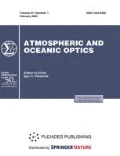Abstract
The results of numerical simulation of some features of the structure of the nocturnal atmospheric boundary layer over the urbanized surface are presented. The mesoscale model includes improved nonlocal parametrization of turbulence developed based on the three-parameter model of turbulence. The turbulent Prandtl number appears to be stably dependent on the gradient Richardson number, and the vertical turbulent heat transport is contragradient. It was shown that the structural features of an “upside-down” boundary layer are detected in the stable atmospheric boundary layer.
Similar content being viewed by others
References
L. Mahrt and D. Vickers, “Contrasting Vertical Structures of Nocturnal Boundary layer Layers,” Bound.-Layer Meteor. 105, 351 (2002).
B. B. Balsley, R. G. Frehlich, M. L. Jensen, and Y. Meiller, “High-Resolution in situ Profiling through the Stable Boundary Layer: Examination of the SBL Top in Terms of Minimum Shear, Maximum Stratification, and Turbulence Decrease,” J. Atmos. Sci. 63, 1291 (2006).
R. M. Banta, Y. L. Pichugina, and W. A. Brewer, “Turbulent Velocity-Variance Profiles in the Stable Boundary Layer Generated by a Nocturnal Low-Level Jet,” J. Atmos. Sci. 63, 2700 (2006).
Y. Ohya Y., “Wind-Tunnel Study of Atmospheric Stable Boundary Layers over a Rough Surface,” Bound.-Layer Meteor. 98, 57 (2001).
A. F. Kurbatskii and L. I. Kurbatskaya, “Three-Parametric Model of Turbulence for the Atmospheric Boundary Layer over an Urbanized Surface,” Izv. Ross. Akad. Nauk Ser. Fiz. Atm. Okeana 42(4), 476 (2006) [Izv. Atm. Ocean. Phys. 42, 439 (2006)].
T. R. Oke, Boundary Layer Climates (Gidrometeoizdat, Leningrad, 1982; Methuen, London, 1987).
A. F. Kurbatskii, “Computational Modeling of the Turbulent Penetrative Convection above the Urban Heat Island in a Stably Stratified Environment,” J. Appl. Meteor. 40, 1748 (2001).
A. F. Kurbatskii and L. I. Kurbatskaya, “Modeling and Simulation of Thermal Air Circulation above an Urbanized Area,” in Proceedings of the 5th IASME/WSEAS International Conference in Heat Transfer, Thermal Engineering and Environment, Athens, Greece, 2007, p. 220.
A. F. Kurbatskii, “Countergradient Heat Transfer in the Atmospheric Boundary Layer over a Rough Surface,” Izv. Atm. Ocean. Phys. 44(2), 160 (2007).
T. C. Vu, Y. Ashie, and T. Asaeda, “A k-ɛ Turbulence Model for the Atmospheric Boundary Layer Including Urban Canopy,” Bound.-Layer Meteorology, 102, 459 (2002).
S.-M. Lee, W. Giori, M. Princevac, and H. J. S. Fernando, “Implementation of a Stable PBL Turbulence Parameterization for the Mesoscale Model MM5: Nocturnal Flow in Complex Terrain,” Bound.-Layer Meteorology, 119, 109 (2006).
P. Monti, H. J. S. Fernando, M. Princevac, and W. C. Chan, “Observations of Flow and Turbulence in the Nocturnal Boundary Layer over a Slope,” J. Atmos. Sci. 59, 2513 (2002).
A. F. Kurbatskii, “Contragradient Heat Transport in the Atmospheric Boundary Layer over a Rough Surface,” Izv. Ross. Akad. Nauk Ser. Fiz. Atm. Okeana, 44(2), 1 (2008) [Izv. Atm. Ocean. Phys.].
J. Cuxart and M. A. Jimenez, “Mixing Processes in a Nocturnal Low-Level Jet: An LES Study,” J. Atmos. Sci. 64, 1666 (2007).
I. Esau and Q. Byrkjedal, “Application of Large-Eddy Simulation Database to Optimization of First Closures for Neutral and Stably Stratified Boundary Layers,” Bound.-Layer Meteor. 125, 207 (2007).
R. J. Beare, M. K. MacVean, A. A. M. Holstag, J. Cuxart, I. Esau, J. C. Golaz, M. A. Jimenez, M. Khairoudinov, V. Kosovic, D. Lewellen, T. S. Lund, J. K. Lunduist, A. McCabe A., A. F. Moene, Y. Noh, S. Raash, and P. Sullivan, “An Intercomparison of Large Eddy Simulations of the Stable Boundary Layer,” Bound.-Layer Meteor. 118, 247 (2006).
J. K. Lundquist and J. D. Mirocha, “Interaction of Nocturnal Low-Level Jets with Urban Geometries as Seen in Joint Urban 2003 Data,” J. Appl. Meteorol. Climatol. 47, 44 (2008).
G. J. Steeneveld, B. J. H. van de Wiel, and A. A. V. Holstag, “Modeling the Evolution of the Atmospheric Boundary Layer Coupled to the Land Surface for Three Contrasting Nights in CASES-99,” J. Atmos. Sci. 63, 920 (2006).
Author information
Authors and Affiliations
Additional information
Original Russian Text © A.F. Kurbatskii, L.I. Kurbatskaya, 2009, published in Optika Atmosfery i Okeana.
Rights and permissions
About this article
Cite this article
Kurbatskii, A.F., Kurbatskaya, L.I. Modeling of the vertical structure of the nocturnal boundary layer over a rough surface. Atmos Ocean Opt 22, 173–179 (2009). https://doi.org/10.1134/S1024856009020067
Received:
Published:
Issue Date:
DOI: https://doi.org/10.1134/S1024856009020067


